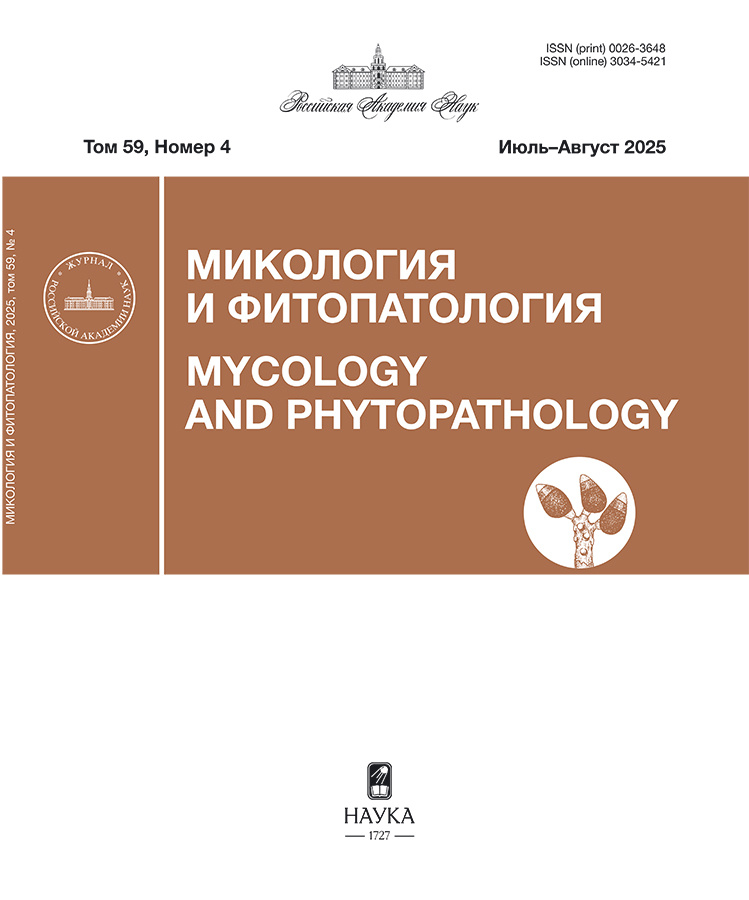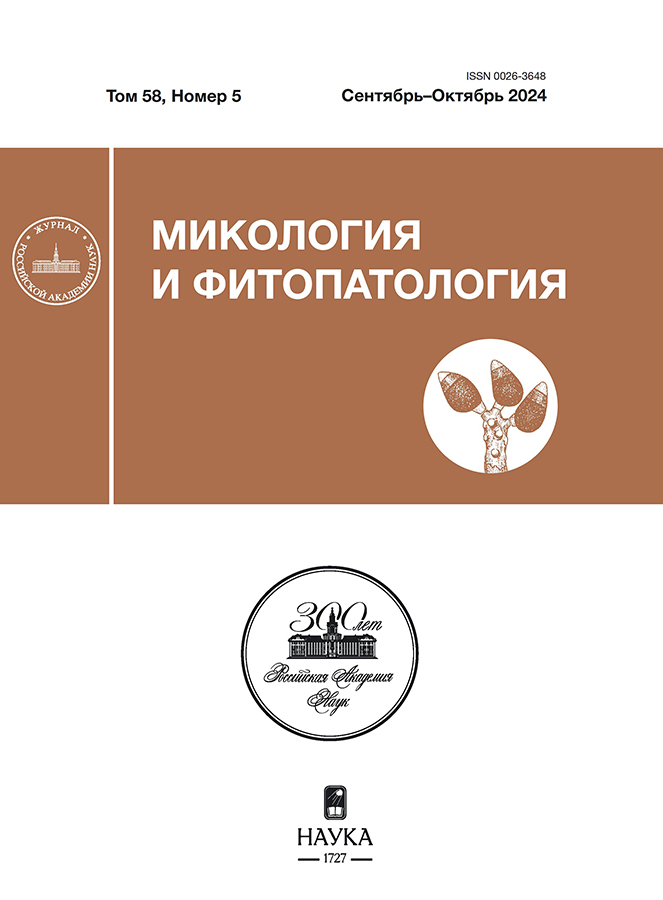Обзор и таксономия Phragmidium mucronatum (Pucciniales) и родственных видов, обитающих на розах в европейской части России
- Авторы: Малышева В.Ф.1, Дудка В.А.1, Малышева Е.Ф.1, Капелян А.И.1
-
Учреждения:
- Ботанический институт им. В. Л. Комарова РАН
- Выпуск: Том 58, № 5 (2024)
- Страницы: 368-380
- Раздел: БИОРАЗНООБРАЗИЕ, СИСТЕМАТИКА, ЭКОЛОГИЯ
- URL: https://rjraap.com/0026-3648/article/view/655934
- DOI: https://doi.org/10.31857/S0026364824050058
- EDN: https://elibrary.ru/uoxwsj
- ID: 655934
Цитировать
Полный текст
Аннотация
В статье представлены результаты детального обследования культурных роз, произрастающих на европейской территории России, на зараженность грибами рода Phragmidium, вызывающими ржавчинную болезнь роз. Основным объектом исследования был розарий Ботанического сада Петра Великого БИН РАН (Санкт- Петербург). Всего было изучено пять дикорастущих видов и 43 сорта роз из семи садовых групп. В результате морфологического анализа пораженных частей растений, детальной микроскопии (с использованием светового и сканирующего электронного микроскопа) собранных образцов грибов, а также анализа данных ДНК, было идентифицировано четыре вида Phragmidium (P. mucronatum, P. fusiforme, P. tuberculatum и P. rosae-pimpinellifoliae). Интересно, что все выявленные виды оказались принадлежащими к группе морфологически сходных видов из комплекса P. mucronatum. В ходе исследования впервые были получены нуклеотидные последовательности ITS для P. fusiforme, P. mucronatum и P. rosae-pimpinellifoliae и LSU для P. rosae-pimpinellifoliae, ранее отсутствовавшие в базах данных. Для всех изученных видов Phragmidium приведены уточненные морфологические описания и иллюстрации макро- и микроструктур. Для сравнения изученных видов с другими представителями рода и определения их филогенетического положения был проведен филогенетический анализ на основе двух генетических маркеров (ITS и LSU).
Ключевые слова
Полный текст
Об авторах
В. Ф. Малышева
Ботанический институт им. В. Л. Комарова РАН
Автор, ответственный за переписку.
Email: v_malysheva@binran.ru
Россия, Санкт-Петербург
В. А. Дудка
Ботанический институт им. В. Л. Комарова РАН
Email: vdudka@binran.ru
Россия, Санкт-Петербург
Е. Ф. Малышева
Ботанический институт им. В. Л. Комарова РАН
Email: e_malysheva@binran.ru
Россия, Санкт-Петербург
А. И. Капелян
Ботанический институт им. В. Л. Комарова РАН
Email: akapelyan@binran.ru
Россия, Санкт-Петербург
Список литературы
- Adritskaya N.A., Kapelyan A.I. Assessment of modern garden rose cultivars in the rosarium of Peter the Great Botanical Garden. Contemporary horticulture. 2023. No. 4. P. 145– 155. (In Russ.). https://doi.org/10.52415/23126701_2023_0414
- Aime M.C. Toward resolving family-level relationships in rust fungi (Uredinales). Mycoscience. 2006. V. 47(3). P. 112–122. https://doi.org/10.1007/S10267-006-0281-0
- Aime M.C., Bell C.D., Wilson A.W. Deconstructing the evolutionary complexity between rust fungi (Pucciniales) and their plant hosts. Studies in Mycology. 2018. V. 89. P. 143– 152. https://doi.org/10.1016/j.simyco.2018.02.002
- Alaei H., De Backer M., Nuytinck J. et al. Phylogenetic relationships of Puccinia horiana and other rust pathogens of Chrysanthemum × morifolium based on rDNA ITS sequence analysis. Mycol. Res. 2009. V. 113. P. 668–683. https://doi.org/10.1016/j.mycres.2009.02.003
- Alfaro M.E., Zoller S., Lutzoni F. Bayes or bootstrap? A simulation study comparing the performance of Bayesian Markov chain Monte Carlo sampling and bootstrapping in assessing phylogenetic confidence. Mol. Biol. Evol. 2003. V. 20. P. 255–266. https://doi.org/10.1093/molbev/msg028
- Azbukina Z.M. The rust fungi. (Lover plants, fungi and mosses of the Russian Far East. Fungi; V. 5). Vladivostok, Dalnauka, 2005. (In Russ.)
- Barilli E., Satovic Z., Sillero J.C. et al. Phylogenetic analysis of Uromyces species infecting grain and forage legumes by sequence analysis of nuclear ribosomal internal transcribed spacer region. J. Phytopathol. 2010. V. 159: 137– 145. https://doi.org/10.1111/j.1439-0434.2010.01736.x
- Beenken L., Zoller S., Berndt R. Rust fungi on Annonaceae II: The genus Dasyspora Berk. et M.A. Curtis. Mycologia. 2012. V. 104 (3). P. 659–681. https://doi.org/10.3852/11-068
- Brandenburger W. Vademecum zum Sammeln parasitischer Pilze: mit besonderer Berücksichtigung der in Mitteleuropa vorkommenden Uredinales, Ustilaginales, Erysiphales, Taphrinales und Peronosporales. Stuttgart, Ulmer, 1963.
- Cummins G., Hiratsuka Y. Illustrated genera of rust fungi, 3rd edn. American Phytopathological Society Press, St. Paul, Minnesota, 2003.
- Dietel P. Über die Arten der Gattung Phragmidium. Hedwigia. 1905. V. 44. P. 330–346.
- Floate K.D., Whitham T.G. The hybrid bridge hypothesis – host shifting via plant hybrid swarms. American Naturalist. 1993. V. 141. P. 651–662.
- Gäumann E. Die Rostpilze Mitteleuropas mit besonderer Berücksichtigung der Schweiz. Büchler, Bern, 1959.
- Hillis D.M., Bull J.J. An empirical test of bootstrapping as a method for assessing confidence in phylogenetic analysis. Syst. Biol. 1993. V. 42. P. 182–192. https://doi.org/10.1093/sysbio/42.2.182
- Kasai M. On the Japanese species of Phragmidium. Trans. Sapporo Nat. Hist. Soc. 1910. V. 3. P. 25–51.
- Katoh K., Rozewicki J., Yamada K.D. MAFFT online service: multiple sequence alignment, interactive sequence choice and visualization. Brief. Bioinformatics. 2019. V. 20 (4). P. 1160–1166. https://doi.org/10.1093/bib/bbx108
- Kuprevitch V.F., Ulyanishchev V.I. Keybook to the rust fungi of the USSR. Minsk, Nauka i tekhnika, 1975. (In Russ.)
- Letunic I., Bork P. Interactive Tree Of Life (iTOL) v4: Recent updates and new developments. Nucleic Acids Res. 2019. V. 47. P. W256–W259. https://doi.org/10.1093/nar/gkz239
- Liu Y., Cao B., Tao S. et al. Phragmidium species parasitizing species of Rosaceae in Tibet, China, with descriptions of three new species. Mycol. Progr. 2018. V. 17. P. 967–988. https://doi.org/10.1007/s11557-018-1406-5
- Liu Y., Ono Y., Kakishima M. et al. Taxonomy and phylogenetic position of Phragmidium altaicum, a newly described rust fungus on Rosa, based on molecular and morphological data. Phytotaxa. 2019. V. 423 (3). P. 187–194. https://doi.org/10.11646/phytotaxa.423.3.7
- Liu Y., Liang Y.M., Ono Y. Taxonomic revision of species of Kuehneola and Phragmidium on Rosa, including two new species from China. Mycologia. 2020. V. 112 (4). P. 742–752. https://doi.org/10.1080/00275514.2020.1753426
- Maier W., Begerow D., Weiß M. et al. Phylogeny of the rust fungi: an approach using nuclear large subunit ribosomal DNA sequences. Can. J. Botany. 2003. V. 81 (1). P. 12–23. https://doi.org/10.1139/b02–113
- Mokritskaya M.S. Rose rust and its control measures in the conditions of the Leningrad region. Proc. Inst. Appl. Zool. Phytopathol. 1958. V. 5. P. 67–87. (In Russ.)
- Mokritskaya M.S. Methodical instruction on determination of rust species of the genus Phragmidium Link on Rosa L. 1974. Leningrad, VIR. (In Russ.)
- Ono Y. Phragmidium satoanum, a new rust pathogen of Rosa hirtula in Japan. Mycoscience. 2019. V. 60. P. 237–246. https://doi.org/10.1016/j.myc.2019.05.001
- Rambaut A., Drummond A.J., Xie D. et al. Posterior summarisation in Bayesian phylogenetics using Tracer 1.7. Syst. Biol. 2018. V. 67. P. 901–904. https://doi.org/10.1093/sysbio/syy032
- Ritz Ch.M., Maier W.F.A., Oberwinkler F. et al. Different evolutionary histories of two Phragmidium species infecting the same dog rose hosts. Mycol. Res. 2005. V. 109 (5). P. 603–609. https://doi.org/10.1017/S0953756205002844
- Ronquist F., Teslenko M., van der Mark P. et al. MrBayes 3.2: Efficient Bayesian phylogenetic inference and model choice across a large model space. Syst. Biol. 2012. V. 61. P. 539–542. https://doi.org/10.1093/sysbio/sys029
- Shattock R. Phragmidium rubi-idaei (DC.) P. Karsten. In: I.M. Smith, J. Dunez, R.A. Lelliot, D.H. Phillips, A.S. Archer (eds). European Handbook of Plant Diseases. New York, Wiley, 1988. P. 483.
- Scholler M., Aime M.C. On some rust fungi (Uredinales) collected in an Acacia koa – Metrosideros polymorpha woodland, Mauna Loa Road, Big Island, Hawaii. Mycoscience. 2006. V. 47 (3). P. 159–165. https://doi.org/10.1007/s10267-006-0309-5
- Svyazeva O.A. Trees, shrubs and vines in the Park of the Botanical Garden of the Botanical Institute V.L. Komarov (To the history of the introduction of the culture). St. Petersburg, Rostock, 2005. (In Russ.)
- Sun J.-E., Zhang Q., Luo W.-M. et al. Four new Phragmidium (Phragmidiaceae, Pucciniomycetes) species from Rosaceae plants in Guizhou Province of China. MycoKeys. 2022. V. 93. P. 193–213. https://doi.org/10.3897/mycokeys.93.90861
- Sydow H. Verwandtschaftsverhältnisse und des gegenwärtigen Entwicklungs-anges zur Umgrenzung der Gattungen bei den Uredineen. Mycology. 1921. V. 19. P. 161–175.
- Tamura K., Stecher G., Kumar S. MEGA11: Molecular Evolutionary Genetics Analysis version 11. Mol. Biol. and Evol. 2021. V. 38. P. 3022–3027. https://doi.org/10.1093/molbev/msab120
- Tkachenko K., Kapelian A. The history of the introduction of species of the genus Rosa to St. Petersburg, Russia. In: A. Muratov, S. Ignateva (eds.). Fundamental and applied scientific research in the development of agriculture in the Far East (AFE-2021). AFE2021. Lecture Notes in Networks and Systems (LNNS). Cham, Springer, 2022. Vol. 353. P. 581–588. https://doi.org/10.1007/978-3-030-91402-8_65
- Trifinopoulos J., Nguyen L.-T., von Haeseler A. et al. W-IQ-TREE: a fast online phylogenetic tool for maximum likelihood analysis. Nucleic Acids Res. 2016. V. 44. P. W232–W235. https://doi.org/10.1093/nar/gkw256
- Vilgalys R., Hester M. Rapid genetic identification and mapping of enzymatically amplified ribosomal DNA from several Cryptococcus species. J. Bacteriology. 1990. V. 172 (8). P. 4238–4246. https://doi.org/10.1128/jb.172.8.4238-4246.1990
- Wahyuno D., Kakishima M., Ono Y. Morphological analyses of urediniospores and teliospores in seven Phragmidium species parasitic on ornamental roses. Mycoscience. 2001. V. 42. P. 519–533. https://doi.org/10.1007/BF02460950
- Wei S.X. A taxonomic study of the genus Phragmidium of China. Mycosystema. 1988. V. 1. P. 179–210.
- Wenzl H. Knospengallen durch Rosenrost. Zeitschrift für Pflanzenkrankheiten (Pflanzenpathologie) und Pflanzenschutz. 1936. V. 46 (3/4). P. 204–214.
- Williams P.H. Investigations on the rust of roses, Phragmidium mucronatum Fr. Ann. App. Biol. 1938. V. 25. P. 730–741.
- Wingfield B.D., Ericson L., Szaro T. et al. Phylogenetic patterns in the Uredinales. Australasian Plant Pathol. 2004. V. 33 (3). P. 327–335. https://doi.org/10.1071/AP04020
- Yun H.Y., Minnis A.M., Kim Y.H. et al. The rust genus Frommeëlla revisited: a later synonym of Phragmidium after all. Mycologia. 2011. V. 103 (6). P. 1451–1463. https://doi.org/10.3852/11-120
- Zhao P., Zhang Z.F., Hu D.M. et al. Contribution to rust flora in China I, tremendous diversity from natural reserves and parks. Fungal Diversity. 2021. V. 5 (1). P. 1–58. https://doi.org/10.1007/s13225-021-00482-w
- Адрицкая Н.А., Капелян А.И. (Adritskaya, Kapelyan) Оценка современных сортов садовых роз в розарии Ботанического сада Петра Великого // Современное садоводство. 2023. № 4. С. 145–155. https://doi.org/10.52415/23126701_2023_0414
- Азбукина З.М. (Azbukina) Ржавчинные грибы. (Низшие растения, грибы и мохообразные Дальнего Востока России. Грибы; Т. 5). Владивосток: Дальнаука, 2005. 616 с.
- Купревич В.Ф., Ульянищев В.И. (Kuprevitch, Ulyanishchev) Определитель ржавчинных грибов СССР. Минск: Наука и техника, 1975. 336 с.
- Мокрицкая М.С. (Mokritskaya) Ржавчина роз и меры борьбы с ней в условиях Ленинградской области // Сб. работ ин-та прикладной зоологии и фитопатологии. 1958. Вып. 5. С. 67–87.
- Мокрицкая М.С. (Mokritskaya) Методическое указание по определению видов ржавчины из рода Phragmidium Link на Rosa L. Ленинград, ВИР, 1974. 69 с.
- Связева О.А. (Svyazeva) Деревья, кустарники и лианы парка Ботанического сада Ботанического института им. В.Л. Комарова (К истории введения в культуру). СПб., Росток, 2005. 384 с.
Дополнительные файлы
















